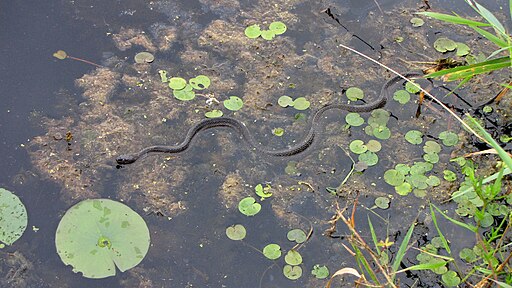How to Get Rid of Snakes in a Pond (and Keep Them Away for Good)
Pond Academy is reader-supported. Buying through links on our site may earn us an affiliate commission. As an Amazon Associate I earn from qualifying purchases.
Finding a snake in your pond can be a frightening experience for some.
And, in some cases, may even prove harmful to you and your fish.
Let’s look at how to get rid of these annoying water snakes…
Plus, the best ways to prevent them from ever coming back.
How To Get Rid of Water Snakes In Pond

Snakes have been known to prey on smaller pond fish, and if venomous, can even be a threat to you.
For these reasons, it’s usually a good idea to remove them as quickly as possible.
![]() Warning!
Warning!
We don’t recommend you try to catch the snake yourself unless you are absolutely certain that it is not venomous. Snake removal is best left to a professional as they have the proper tools and experience to catch these reptiles. However, if it is just a lone snake and you know it’s not a threat, below are the steps to remove it from your pond.
Step 1: Wear Proper Attire
We always recommend you wear protective clothing before attempting to catch the snake. Even if you are fairly certain it is not venomous, it may still bite. So, make sure you wear:
- A long-sleeved shirt or jacket
- Long pants
- A thick pair of gloves
- Rugged boots
Of course, the above clothing won’t stop all snake bites, but it might provide just enough protection to prevent their fang’s from breaking your skin.
Step 2: Removing The Snake
To physically remove the snake, you’ll want to use snake tongs to grab the snake. These tongs will make it easy to get a good grip on the snake while maintaining a safe distance in case the snake begins to struggle and/or breaks free.
Follow these tips to make the removal process go as smoothly as possible.
- Grab the snake with the tongs a few inches down its body behind its head. If you grab its head, you may injure the snake. And if you grab too far down the body you risk giving it enough room to bite you.
- Securely grasp the snake with the tongs, but don’t squeeze with too much pressure. If you squeeze too hard it will just agitate the snake and make it more dangerous.
- If you are relocating the snake somewhere within walking distance, don’t lift it completely off the ground. Instead, simply lift the head off the ground and slowly drag it to your desired location.
Step 3: Relocation
Once you have a hold of the snake, we need to relocate it (we don't recommend you kill it). It’s good to have this figured out before even attempting to grab the snake. Ideally, you want to relocate the snake as far away from your pond as possible. You could always put the snake in a bucket with a screw top lid and drive it somewhere or simply drag it a safe distance away.
With the latter method, the snake could slither right back to your pond, so we’ll need to learn how to keep snakes out of our pond (and yard) for good.
How To Keep Snakes Out Of A Pond
Once the snake is removed, we’ll need to make sure it (and any other snakes) don’t return.
Just keep in mind that ponds do attract snakes. Along with other animals like pond snails, turtles and other local wildlife.
Some common snakes that live in ponds, or may be attracted to them, include garter snakes, corn snakes, black rat snakes, and water snakes.
With that said, you can effectively keep snakes out of a pond by utilizing a few tips and tricks. Here’s how to snake proof a pond (and yard) to stop them from returning.
Remove Snake Shelters
One of the most effective ways to ensure snakes don’t enter your yard or pond is to remove any spots they might use for shelter or as a hiding place. This includes:
- Keeping Grass Short: Be sure to gut the grass in your yard and especially around your pond regularly. Some people like to let the grass around their pond grow tall to give it a more natural look, but that just gives snakes a place to hide.
- Remove Piles: Move any wood piles, compost piles, mulch, etc. away from your pond and completely out of your yard if possible. These piles provide an excellent place for snakes to live and nest.
- Trim Bushes & Shrubs: Overgrown bushes and shrubs can also provide ideal spaces for snakes to live and hide. Keep them trimmed up to eliminate them as potential hiding places.
- Keep Yard Clean: Yard care not only makes your yard more aesthetically pleasing, it also can eliminate potential hiding places. This includes raking up any leave piles and branches, as well as picking up any toys, trash and removing overgrown vegetation.
- Reduce Standing Water: Snakes prefer places that are cool and damp. So, after a good rain, walk around your yard and identify any spots that retain water. Fill in any holes and don’t forget to check any flower pots and empty those, as well, of standing water.
Remove Food Sources
Another way to prevent snakes from stumbling upon your pond is to eliminate common food sources found around your backyard. One of the most common of these food sources is rodents. If you’ve noticed any mice, rats or other rodents on your property you may want to consider eliminating them. Even if you haven’t noticed them, they may still be there, especially if you have snakes around.
Setup enclosed mouse traps around the perimeter of your yard or pond. Don’t use an open trap as the snakes can just eat the dead mice off them and they can be hazardous to other wildlife, your pets, and even young children.
Do Snakes Eat Fish In A Pond?
Yes, some snakes will eat fish in your pond. Koi fish are generally safe because of their size, but if you have smaller fish, they may be potential prey. However, if we can eliminate other food sources around your pond and in your yard, then snakes won’t be led to your pond in the first place.
Snake Repellents
Once you’ve removed any food sources and hiding spots for snakes, it’s time to make your pond (and property surrounding your pond) as unappealing as possible.
There is a multitude of products and methods out there to deter snakes. Some of the more popular methods that are safe for pets and people include:
- Plants: Snakes hate the smell of certain plants like lemon grass, marigold, wormwood, and garlic. Strategically planting a few of these natural snake repellents around your property will effectively help prevent snakes from slithering onto your property. As an added bonus, many of these plants, like Lemon Grass, also help get rid of mosquitos.
- Plastic owl: A realistic looking plastic owl setup near your pond will help deter snakes and other pests including rodents and birds. It’s one of the simplest, most cost-effective and low maintenance solutions to keep pests away from your pond or water garden.
- Essential Oils: Certain essential oils like cinnamon and clove oil may be an effective and natural snake repellent. This is for the same reason they don’t like certain plants, they hate the smell of them. Simply mix 10-20 drops of the oil with a cup of water in a spray bottle and spray the desired area. Shake the bottle to mix the water and oil before each use.
- Repelling Granules: Victor Snake-A-Way repelling granules is a mixture of naphthalene and sulfur that essentially deters snakes because of the scent. It’s safe for use around pets, plants, and people. Do not use this in your pond, but rather around the perimeter of your yard to keep snakes from slithering onto your property.
Snake Traps
If those pesky water snakes still aren’t deterred and continually return to your pond, then it may be time to employ a snake trap.
Snake traps essentially lure the snake into the trap with an appealing scent and either securely contains them inside or uses a sticky surface to trap them. We don’t recommend using kill traps, but if you do be sure it’s legal in your area as some snakes are protected and are on endangered species lists.











